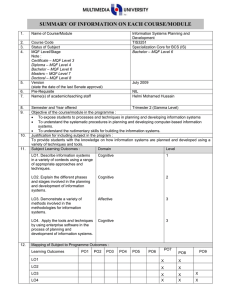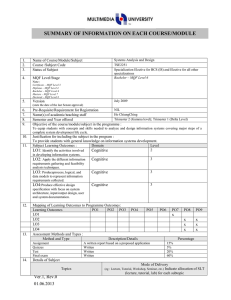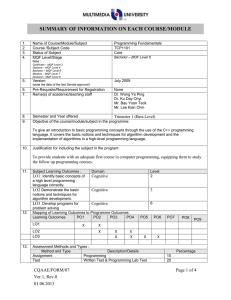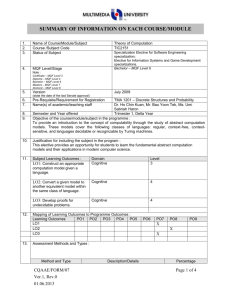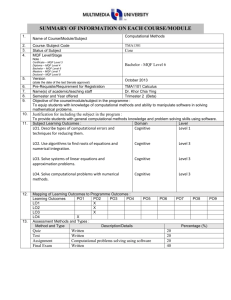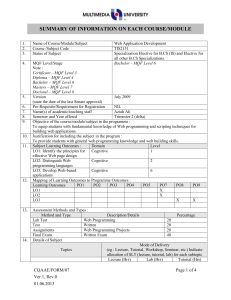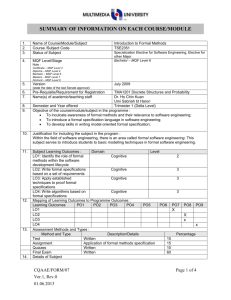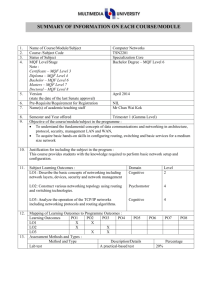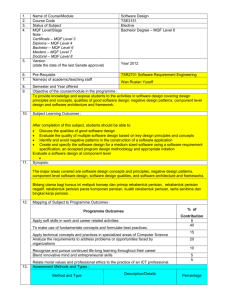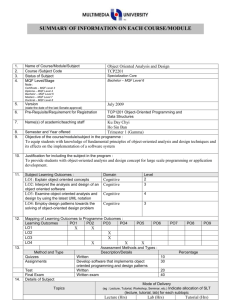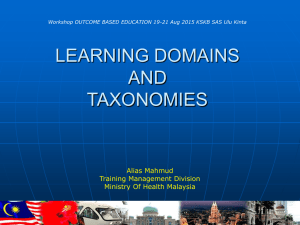Full Description
advertisement
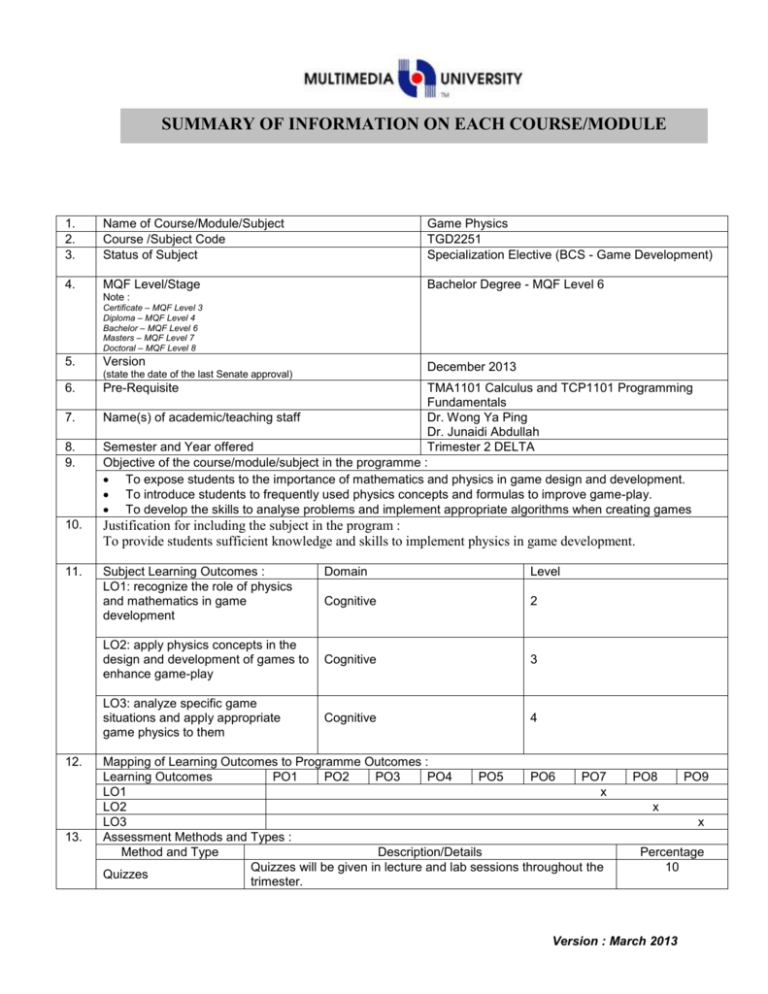
SUMMARY OF INFORMATION ON EACH COURSE/MODULE 1. 2. 3. Name of Course/Module/Subject Course /Subject Code Status of Subject Game Physics TGD2251 Specialization Elective (BCS - Game Development) 4. MQF Level/Stage Bachelor Degree - MQF Level 6 Note : Certificate – MQF Level 3 Diploma – MQF Level 4 Bachelor – MQF Level 6 Masters – MQF Level 7 Doctoral – MQF Level 8 5. Version December 2013 (state the date of the last Senate approval) 6. 7. 8. 9. Pre-Requisite TMA1101 Calculus and TCP1101 Programming Fundamentals Name(s) of academic/teaching staff Dr. Wong Ya Ping Dr. Junaidi Abdullah Semester and Year offered Trimester 2 DELTA Objective of the course/module/subject in the programme : To expose students to the importance of mathematics and physics in game design and development. To introduce students to frequently used physics concepts and formulas to improve game-play. To develop the skills to analyse problems and implement appropriate algorithms when creating games 10. Justification for including the subject in the program : To provide students sufficient knowledge and skills to implement physics in game development. 11. Subject Learning Outcomes : LO1: recognize the role of physics and mathematics in game development 12. 13. Domain Level Cognitive 2 LO2: apply physics concepts in the design and development of games to enhance game-play Cognitive 3 LO3: analyze specific game situations and apply appropriate game physics to them Cognitive 4 Mapping of Learning Outcomes to Programme Outcomes : Learning Outcomes PO1 PO2 PO3 PO4 PO5 PO6 PO7 LO1 x LO2 LO3 Assessment Methods and Types : Method and Type Description/Details Quizzes will be given in lecture and lab sessions throughout the Quizzes trimester. PO8 PO9 x x Percentage 10 Version : March 2013 Assignments 14. Tests Details of Subject Topics Programming assignments and projects will be given throughout the trimester. Written or lab tests will be given. 70 20 Mode of Delivery (eg : Lecture, Tutorial, Workshop, Seminar, etc.) Indicate allocation of SLT (lecture, tutorial, lab) for each subtopic 1. Introduction to Game Physics Lecture 1 Lab 0 3 2 4 4 4 4 6 6 4 4 2 2 4 4 The importance of physics to games, and a brief history. Overview of the current state of the art, software and hardware. 2. Mathematical Concepts Units and measurements. Scientific notation. Coordinate systems. Scalars and vectors. Matrices. Derivatives. Differential equations. 3. Newtonian Mechanics Inertia (1st Law). Force. Mass and acceleration (2nd Law). Equal and opposite forces (3rd Law). Types of forces. Work. Energy. Power. 4. Basic Kinematics Translational motion. Spring motion. Rotational motion. Torque. Angular acceleration. Rigid body motion. Rolling motion. 5. Projectiles Modeling projectile motion. Gravity only model of projectiles. Aerodynamic drag on motion. Wind effect on motion. Spin effects on motion. 6. Collisions Conservation of linear momentum. Elastic and inelastic collision. 2D and 3D collision. Frictional effects. Collision detection. 7. Basic Quaternions Introduction to quaternions. Quaternion representations. Quaternion operations. 8. Case Studies of Games Applications Ball games. Car racing simulations. Airplane flight simulations. Weaponry. Explosions. Total 15. Total Student Learning Time (SLT) Lectures Labs Face to Face 28 26 28 28 Independent Learning 28 26 Version : March 2013 16. 17. 18. Presentations Quizzes Assignments / Projects Tests Sub Total Total SLT Credit Value Reading Materials : Textbook Palmer, G. Physics for Game Programmers, Apress, 2005. 2 2 0 2 60 6 4 28 8 100 160/40 = 4 => 4 4 Reference Materials Bourg, D. Physics for Game Developers, O’Reilly Media, Inc., 2001. Eberly, D.H. Game Physics, Morgan Kaufmann, 2003. Appendix (to be compiled when submitting the complete syllabus for the programme) : 1. Mission and Vision of the University and Faculty 2. Programme Objectives or Programme Educational Objectives 3. Programme Outcomes (POs) 4. Mapping of POs to the 8 MQF domain 5. Mapping of Los to the POs 6. Summary of the Bloom’s Taxonomy’s Domain Coverage in all the Los in the format below : Subject Learning Outcomes (please state the learning outcomes) Learning Outcome 1 Learning Outcome 2 Learning Outcome 3 TGD2251 Bloom’s Taxonomy Domain Affective Cognitive Psychomotor 2 3 4 7. Summary of LO to PO measurement 8. Measurement and Tabulation of result for LO achievement 9. MeasurementTabulation of result for PO achievement Mapping Assessment to Learning Outcomes No. Assessment % A1 Quizzes 10 A2 Assignments / Projects 70 A3 Tests 20 LO1 LO2 LO3 X X X X Version : March 2013 Version : March 2013
